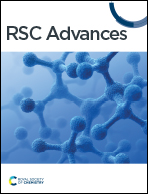
RSC Advances
Subject area
Nanomaterials articles published in the last
6 months

An in situ phase transformation induced mesoporous heterointerface for the alkaline hydrogen evolution reaction
In situ phase transformation is achieved from single-phase Co3O4 to CoO/CoP hybrid phases, which acts as a highly efficient electrocatalyst for the hydrogen evolution reaction.

RSC Adv., 2024,14, 14886-14893
https://doi.org/10.1039/D4RA02063D
Probing capping mechanisms and polymer matrix loading of biogenic vaterite CaCO3–Ag hybrid through X-ray photoelectron spectroscopy (XPS)
XPS revealed Ag+ and Ag0 in biogenic vaterite CaCO3–Ag microspheres. CMC and PSS capping agents influenced Ag species distribution. Polymorph transformations and vaterite's stability were highlighted.

RSC Adv., 2024,14, 14624-14639
https://doi.org/10.1039/D4RA01710B
Photocatalytic degradation of methyl blue dye with H2O2 sensing
ZnO nanoparticles impregnated polymer for the degradation of methyl blue dye with H2O2 sensing colorimetrically and fluorometrically.

RSC Adv., 2024,14, 14606-14615
https://doi.org/10.1039/D4RA01354A
Unleashing the promise of emerging nanomaterials as a sustainable platform to mitigate antimicrobial resistance
The emergence and spread of antibiotic-resistant (AR) bacterial strains and biofilm-associated diseases have heightened concerns about exploring alternative bactericidal methods.

RSC Adv., 2024,14, 13862-13899
https://doi.org/10.1039/D3RA05816F
Recent progress of electrospun nanofibers as burning dressings
Burns are a global public health problem, which brings great challenges to public health and the economy.

RSC Adv., 2024,14, 14374-14391
https://doi.org/10.1039/D4RA01514B
MOF/graphene oxide based composites in smart supercapacitors: a comprehensive review on the electrochemical evaluation and material development for advanced energy storage devices
Driving towards sustainable energy solutions: harnessing metal–organic framework/graphene oxide composites to propel high-efficiency smart supercapacitors.

RSC Adv., 2024,14, 14311-14339
https://doi.org/10.1039/D4RA01027B
Light-driven soft microrobots based on hydrogels and LCEs: development and prospects
In this paper, the driving materials, driving mechanisms and application scenarios of light-driven soft microrobots are reviewed, and their advantages and limitations are discussed. Finally, we pointed out the challenges faced by light-driven soft micro robots and proposed corresponding solutions.

RSC Adv., 2024,14, 14278-14288
https://doi.org/10.1039/D4RA00495G
Flexible tactile sensors with interlocking serrated structures based on stretchable multiwalled carbon nanotube/silver nanowire/silicone rubber composites
A patterned, stretchable, and fully elastomeric multiwalled carbon nanotube (MWCNT)/silver nanowire (Ag NW)/silicone rubber (SR) composite have been developed.

RSC Adv., 2024,14, 13934-13943
https://doi.org/10.1039/D4RA00381K
Exploring the effect of the covalent functionalization in graphene-antimonene heterostructures
van der Waals heterostructure preparation based on hexagonal Sb and graphene, and its subsequent patterning through functionalization with benzyl substituents.

RSC Adv., 2024,14, 13758-13768
https://doi.org/10.1039/D4RA01029A
Nanoparticles incorporated hydrogels for delivery of antimicrobial agents: developments and trends
Nanoparticle-hydrogel systems are versatile biomaterials that possess numerous advantages for biomedical applications. This review focuses on the application of the nanoparticle-hydrogels system for the delivery of antimicrobial agents.
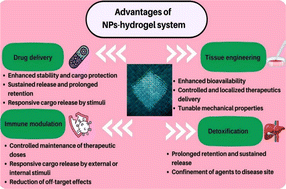
RSC Adv., 2024,14, 13535-13564
https://doi.org/10.1039/D4RA00631C
Advancements in application of chitosan and cyclodextrins in biomedicine and pharmaceutics: recent progress and future trends
The global community is faced with numerous health concerns such as cancer, cardiovascular and neurological diseases, diabetes, joint pain, osteoporosis, among others.
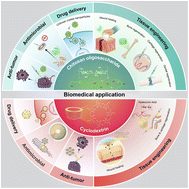
RSC Adv., 2024,14, 13384-13412
https://doi.org/10.1039/D4RA01370K
Recent advances in the functionalization, substitutional doping and applications of graphene/graphene composite nanomaterials
Recently, graphene and graphene-based nanomaterials have emerged as advanced carbon functional materials with specialized unique electronic, optical, mechanical, and chemical properties.

RSC Adv., 2024,14, 13413-13444
https://doi.org/10.1039/D3RA07072G
Smart materials for flexible electronics and devices: hydrogel
In recent years, flexible conductive materials have attracted considerable attention for their potential use in flexible energy storage devices, touch panels, sensors, memristors, and other applications.
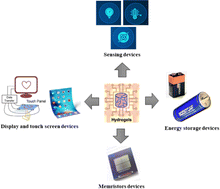
RSC Adv., 2024,14, 12984-13004
https://doi.org/10.1039/D4RA01168F
Novel supramolecular luminescent metallogels containing Tb(III) and Eu(III) ions with benzene-1,3,5-tricarboxylic acid gelator: advancing semiconductor applications in microelectronic devices
Supramolecular metallogels with Tb(III)- and Eu(III)-ions, formed using benzene-1,3,5-tricarboxylic acid, display remarkable stability at room temperature. They hold promise for use in electronics, notably as reliable ambient Schottky barrier diodes.

RSC Adv., 2024,14, 12829-12840
https://doi.org/10.1039/D3RA07903A
Current status of controlled onco-therapies based on metal organic frameworks
Most MOFs for controllable cancer treatment act as drug delivery vehicle and/or anti-cancer agent. Molecules with anti-cancer roles such as chemotherapies, gases, peptides or nucleic acids can be loaded into MOFs that decompose in cancer cells or in the TME to release its cargoes.

RSC Adv., 2024,14, 12817-12828
https://doi.org/10.1039/D4RA00375F
Fabrication of MoS2/rGO hybrids as electrocatalyst for water splitting applications
Environmental degradation and energy constraint are important risks to long-term sustainability in the modern world.

RSC Adv., 2024,14, 12742-12753
https://doi.org/10.1039/D4RA00697F
Innovative surfactant-free synthesis of core–shell SiO2/ZnO particles: rapid ultrasonication and photocatalytic inhibition
This study demonstrates the preparation of SiO2/ZnO core–shell nanoparticles with controllable shell size and their optical properties.

RSC Adv., 2024,14, 12665-12675
https://doi.org/10.1039/D4RA01309C
Insights into the optoelectronic behaviour of heteroatom doped diamond-shaped graphene quantum dots
Investigation of heteroatom (N, B, O, P and S) doping impact on the structural, optoelectronic and photoluminescence properties of diamond-shaped graphene quantum dots for photovoltaics and nanomedical applications, and energy technologies.
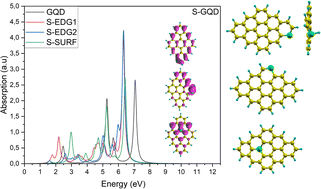
RSC Adv., 2024,14, 12639-12649
https://doi.org/10.1039/D4RA00603H
Dual-functional nano-photosensitizers: Eosin-Y decorated gold nanorods for plasmon-enhanced fluorescence and singlet oxygen generation
Enhancement factors of 110 and 18 for metal-enhanced fluorescence and metal-enhanced SOG, respectively, are obtained from polymer coated gold nanorod cores adsorbed with Eosin Y.
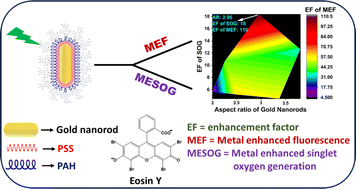
RSC Adv., 2024,14, 12417-12427
https://doi.org/10.1039/D4RA01551G
A self-powered photodetector through facile processing using polyethyleneimine/carbon quantum dots for highly sensitive UVC detection
Ultraviolet C (UVC) photodetectors have garnered considerable attention because the detection of UVC is critical for preventing skin damage in humans, monitoring environmental conditions, and detecting power aging in military applications.
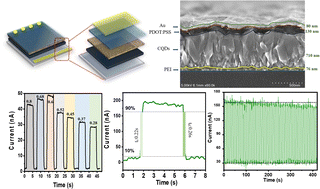
RSC Adv., 2024,14, 12360-12371
https://doi.org/10.1039/D3RA08538D
Investigation into the impact of CeO2 morphology regulation on the oxidation process of dichloromethane
Four distinct CeO2 catalysts featuring varied morphologies (nanorods, nanocubes, nanoparticles, and nano spindle-shaped) were synthesized through a hydrothermal process and subsequently employed in the oxidation of dichloromethane (DCM).

RSC Adv., 2024,14, 12265-12277
https://doi.org/10.1039/D4RA01326C
Advances in superhydrophobic material research: from preparation to electrified railway protection
Superhydrophobic coatings give a solution for the protection of electrical equipment and some corresponding preparation methods.

RSC Adv., 2024,14, 12204-12217
https://doi.org/10.1039/D3RA08180J
High-fidelity synthesis of microhole templates with low-surface-energy-enabled self-releasing photolithography
A self-releasing photolithographic technique is developed to synthesize freestanding polymeric templates with high structural fidelity, smooth surfaces and excellent flexibility.

RSC Adv., 2024,14, 12125-12130
https://doi.org/10.1039/D4RA00660G
Flower-like Ag-decked non-stoichiometric Bi2O3−x/rGO hybrid nanocomposite SERS substrates for an effective detection of Rhodamine 6G dye molecules
Preparation of flower-like non-stoichiometric rGO-Bi2O3/Bi2O2.75 and rGO-Ag-Bi2O3/Bi2O2.75 hybrid thin film nanocomposites as an effective SERS substrate using a liquid/liquid interface method. The increase of hotspots leads to more favourable properties to improve the G-factor.

RSC Adv., 2024,14, 11951-11968
https://doi.org/10.1039/D4RA01286K
PVDF/ZnO piezoelectric nanofibers designed for monitoring of internal micro-pressure
Organic piezoelectric materials are emerging as integral components in the development of advanced implantable self-powered sensors for the next generation.

RSC Adv., 2024,14, 11775-11783
https://doi.org/10.1039/D3RA08713A
Browse by Subject
- All (336 articles)
- Atomic/elemental (14 articles)
- Bioanalytical (65 articles)
- Chemometrics (30 articles)
- Crystallography (163 articles)
- Electroanalytical (55 articles)
- Imaging/microscopy (32 articles)
- Mass spectrometry (20 articles)
- Medical diagnostics (77 articles)
- Microfluidics (17 articles)
- Nanoanalysis (21 articles)
- Separation science (26 articles)
- Spectroscopy (95 articles)
- All (278 articles)
- Bioinorganic chemistry (50 articles)
- Bioorganic chemistry (27 articles)
- Biotechnology (53 articles)
- Cellular chemistry (56 articles)
- Computational (85 articles)
- Drug delivery (79 articles)
- Drug discovery (186 articles)
- Imaging/diagnostics (16 articles)
- Molecular biology (6 articles)
- Nanotechnology (46 articles)
- Natural products (29 articles)
- Pharmacology (88 articles)
- Photobiology (15 articles)
- Polymorphism (pharma) (1 article)
- Structural biology (14 articles)
- Toxicology (5 articles)
- All (559 articles)
- Biomaterials (102 articles)
- Biopolymers (99 articles)
- Carbon materials (100 articles)
- Composites (248 articles)
- Electronic materials (96 articles)
- Encapsulation (1 article)
- Energy applications (85 articles)
- Films/membranes (83 articles)
- Gels & soft matter (36 articles)
- Inorganic materials (49 articles)
- Medical materials (66 articles)
- Nanomaterials (124 articles)
- Optical materials (52 articles)
- Organic materials (57 articles)
- Polymers (133 articles)
- All (352 articles)
- Assembly (11 articles)
- Biotechnology (31 articles)
- Carbon nanomaterials (80 articles)
- Imaging/microscopy (18 articles)
- Nanoanalysis (43 articles)
- Nanocatalysis (33 articles)
- Nanomaterials (215 articles)
- Nanomedicine (44 articles)
- Nanotoxicology (58 articles)
- Optical nanomaterials (36 articles)
- Synthesis (11 articles)
- All (173 articles)
- Bioorganic (17 articles)
- Catalysis (46 articles)
- Fine chemicals (25 articles)
- Natural products (22 articles)
- Physical organic (8 articles)
- Stereochemistry (11 articles)
- Supramolecular (3 articles)
- Sustainable synthesis (34 articles)
- Synthetic methodology (101 articles)
- Total synthesis (13 articles)
- All (327 articles)
- Biophysics (3 articles)
- Charge transfer (30 articles)
- Electrochemistry (13 articles)
- Energy research (19 articles)
- Imaging/microscopy (5 articles)
- Kinetics & dynamics (42 articles)
- Materials (109 articles)
- Mechanics (34 articles)
- Nanoscience (73 articles)
- Photoscience (26 articles)
- Quantum & theoretical (92 articles)
- Simulations (23 articles)
- Single molecules (41 articles)
- Soft matter (5 articles)
- Spectroscopy (7 articles)
- Surfaces & interfaces (70 articles)